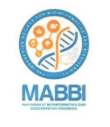Histology Analysis of Tissue Regeneration Process of Digit Tip Mice (Mus musculus) post amputation
Abstract
The ability to regenerate tissue is different for each organism. Mice (Mus musculus) able to regenerate the 3rd phalange of a digit. The tissue regeneration process has four phases are the wound-healing phase, the blastema phase, the regeneration phase, and the maturation phase. Each phase has a different process and different activity of cells. Histological analysis is very important to see the activity of each cell in each phase of tissue regeneration. Through histological analysis we can find out the role of each cell in the tissue regeneration process as well as the processes that occur in tissue regeneration. In this study, we analyzed tissue histology in the digit tip mice at each regeneration phase post amputated. The phalanges were amputated on the 3rd phalanges of digit tip of 24 male mice which had been previously sedated using ketamine / xylazine. Digit tip were allowed to grow and regenerate, and samples were taken on days 0, 1, 3, 5, 10, 15, 25 after amputation. Histological analysis was performed using Hematoxylin-eosin staining on a sample preparation that had been made into paraffin blocks first. The histological showed that at the beginning of the wound, the tissue rapidly forms a thin epidermal layer to cover the wound. In the wound healing phase, some of embryonal cells proliferated and migrated actively. In the blastema phase, granule cells cluster to form various new tissues. In the regeneration phase, new tissue begins to form, such as blood vessel, muscle, bone, and epidermal tissue. In the regeneration phase on day 15, several new tissues have begun to form, such as blood vessel tissue, muscle, hemorrhoid, bone and epidermis. Finally, in the maturation phase on day 25, the tissue morphology process occurs and perfecting the digit tip mice tissue.
Full Text:
PDFDOI: https://doi.org/10.47007/ijobb.v4i2.70
Refbacks
- There are currently no refbacks.
| Indonesian Journal of Biotechnology and Biodiversity Published by: Publishing Department of Esa Unggul University Arjuna Utara No 9 Street Kebon Jeruk Jakarta - 11510 Indonesia | |








.png)

